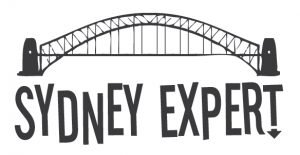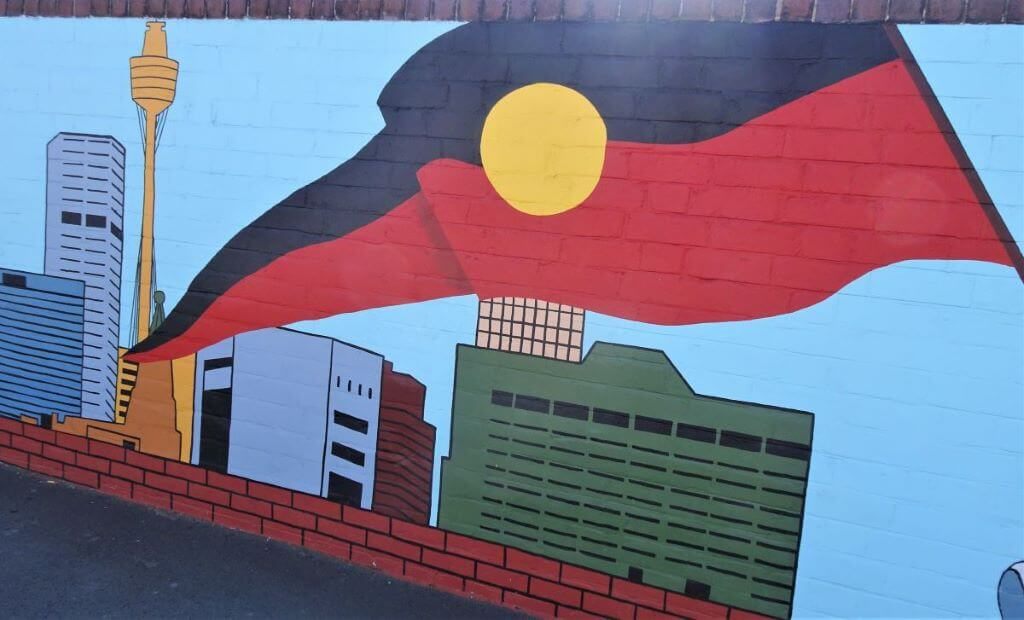Sydney’s Indigenous artists are the source of some of Sydney’s best street art. And while it can seem as if Sydney’s concrete and commercialism have erased Aboriginal presence in the city, the city has a proud and ongoing tradition of Indigenous visual art.
These 20 works tell stories of resistance, both individual and collective, to two hundred years of genocide. And yet despite these hardships, Aboriginal artists continue to create at the ground zero of Australian colonialism, living and embodying the world’s oldest culture.
Below we have curated a list of the best examples of Indigenous street art you can see while out and about in Sydney. The artworks are listed by area so you can keep an eye out for them as your explore Sydney or create your own self guided walks to visit them all. You will find a map included at the bottom of the page.
Aboriginal artworks and Sculptures in Redfern
One of the best places to learn about Indigenous culture in Sydney is Redfern, where you’ll discover a variety of public artworks, with walls adorned with striking murals that reflect the Aboriginal history and of the area.
40, 000 Years
First painted in 1983 by a team of artists led by Carol Ruff, 40,000 Years is a mixture of traditional Aboriginal design, photorealistic depictions of local icons, and two lines of text, taken from the lyrics of 40,000 Years by singer-songwriter Joe Geia.

The mural was designed to ground Aboriginal history within its modern living heart. Over later decades Redfern became notorious for a wide range of social ills, this reputation only fading with the area’s increasing gentrification. Mirroring this decay was the decay of the mural itself, as the elements and neglect took their toll on the paint and brickwork.
“40,000 years is a long long time… 40,000 years still on my mind…”
Joe Geia
But in 2018 a team of students, conservationists, and indigenous artists completed a careful and loving restoration project of the original mural, which once again stands as a proud reminder of Australia’s timeless living history.
Where: On Lawson Street across from Redfern Station.
Welcome to Redfern
Painted between 2012 and 2013 by a team of local artists led by Reko Rennie, Welcome to Redfern covers the outside of a Victorian terrace house inside the Block neighbourhood. Long the cultural hub of Aboriginal life in Sydney, the Block was a group of terraces purchased by the Aboriginal Housing Company in 1972.
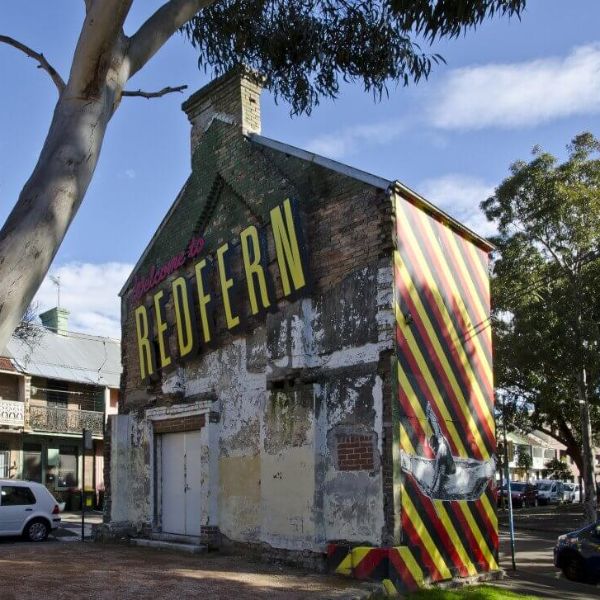
Falling into disrepair and later gentrification, the terrace on which Welcome to Redfern is painted is now one of the few still standing. But Welcome to Redfern remains as a defiant monument to the area’s importance and identity.
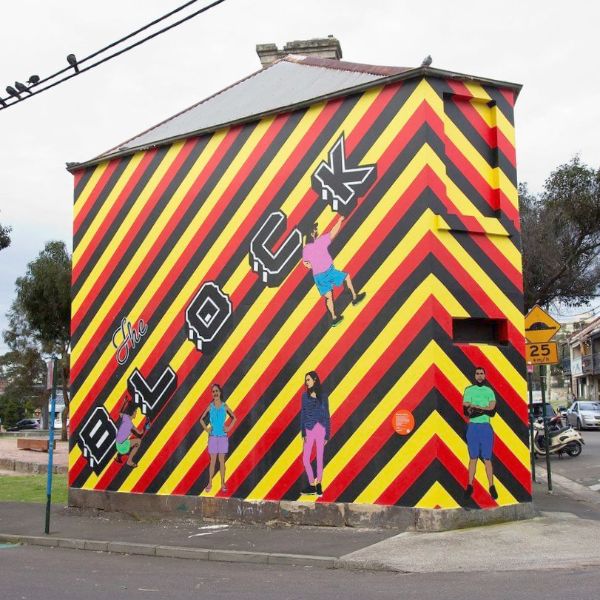
The black, red, and yellow zigzags of the Aboriginal Flag draw the eye of visitors and commuters to historical icons like Pemulwuy and contemporary Aboriginal leaders, while the big-block text gives the mural its name and reminds us of where we are, and what that means.
Where: This Redfern mural sits at the corner of Caroline and Hugo Streets.
United We Stand Divided We Fail the Future
Installed in 2008, United We Stand Divided We Fail is a mural along the back of Hugo Street Reserve in Redfern. Artists Bronwyn Bancroft and Dale Jones-Evans collaborated closely with the local community in the piece’s creation.
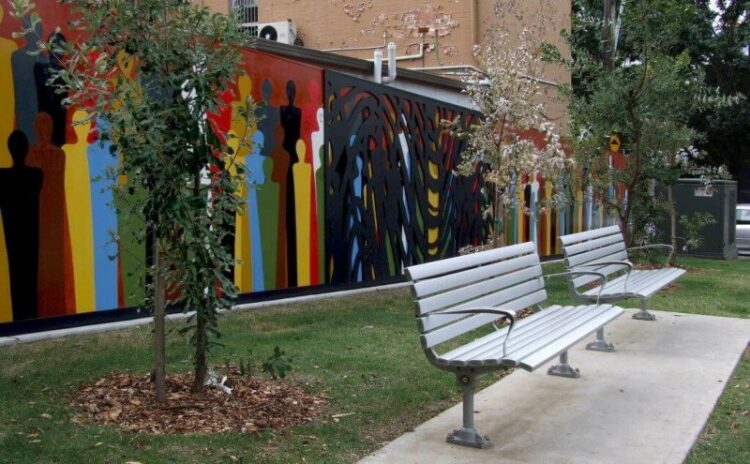
Bancroft, with the assistance of local kids, painted an array of multicolored figures along the reserve’s back wall, figures that represent the area’s custodial spirits in all their diversity. Jones-Evans dedicated his efforts to the crafting of the mural’s screens, black, and laser cut in the style of bush foliage, and placed over parts of the painted wall.
Serving as a backdrop to a much-loved community space, United We Stand Divided We Fail reminds us of the power that unity in diversity brings, and the protective love that power has brought communities over countless generations.
Where: Hugo Street Reserve in Redfern
Bibles and Bullets
Bibles and Bullets is not a single sculpture, but rather a triptych, a collection of three individual pieces arranged together in Redfern Park by artist Fiona Foley.
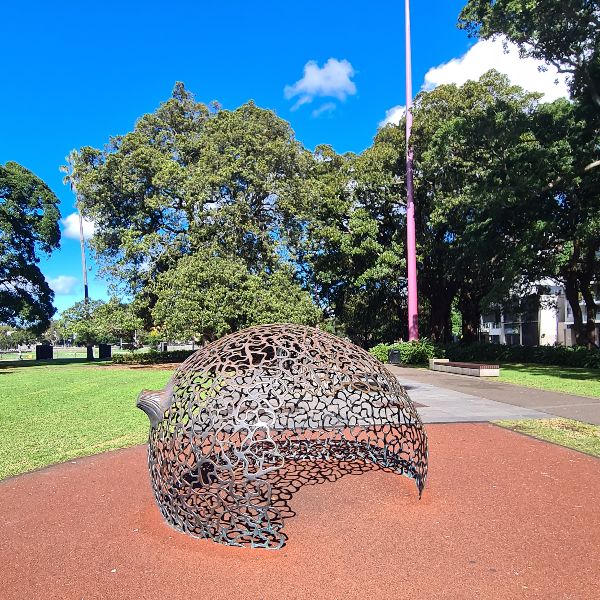
Installed in 2008, Bibles and Bullets comprise a kind of imaginative and thoughtful playground for children of all ages.
The first piece, Intuitive Play, is an array of metallic seed pods derived from the local flora, along with constructions including a wooden boat and a 3D textual representation of creator deity Baiame. Next is the Lotus Line, a row of bronze and stainless-steel lotus flowers emerging from the pavers and acting as fountains. With the water lending an onlooker to contemplation, an excerpt from Paul Keating’s famous Redfern speech is inscribed nearby.
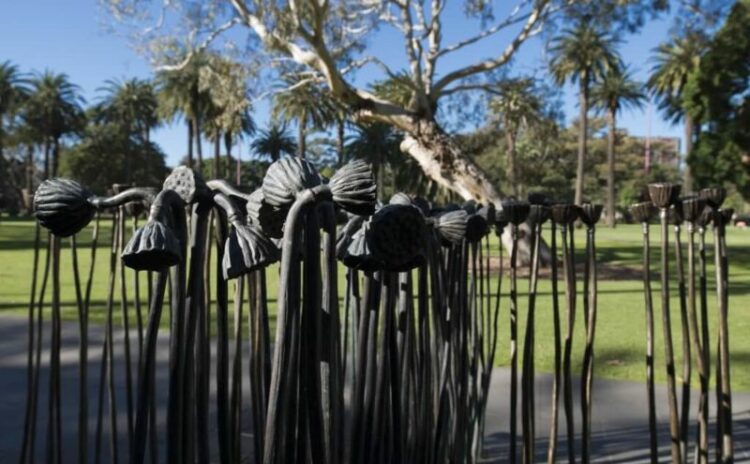
Lastly is Possum Play, a playscape for older children that includes basketball courts and a skate park and incorporates the story of a traditional possum hunt into its design.
Bibles and Bullets is not so much artwork as an environment, taking culture and infusing it into our everyday lives from the earliest of ages
Where: Redfern Park, Redfern Street
Mission Boy Dreams
In 1996 Wyanga, an aged care service for Aboriginal people in inner Sydney and La Perouse was established. In 2005 Wyanga found its permanent home at this site on Cope Street.
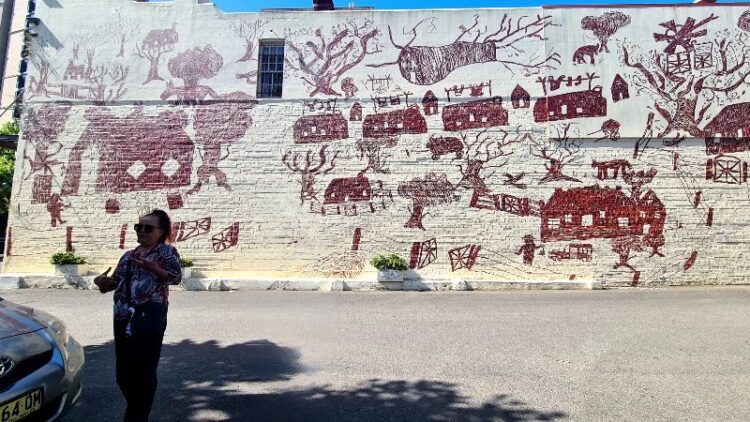
The building’s southern wall showcases the mural Mission Boy Dreams. The mural, with its striking ochre and cream colour scheme, tells a deeply meaningful story. This narrative is not only important to artist Roy Kennedy, but also resonates with the wider Aboriginal community.
Using clear and concise imagery, the mural powerfully depicts the challenges of mission life, capturing the long-lasting suffering experienced by numerous Indigenous Australians.
Where: 35 Cope Street, Redfern
Murals on Regent Street
There are two important murals on Regent Street. On one wall stretches the sorrowful face of an Aboriginal child, painted in sepia by renowned muralist Guido van Helten.
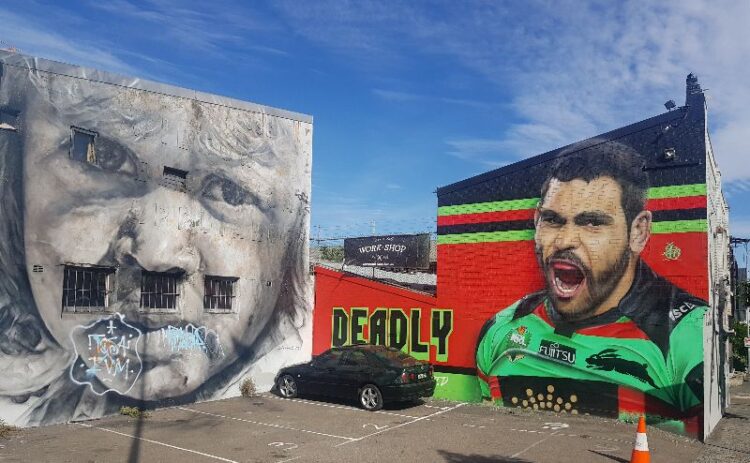
On the walls of the other, a mural with a very different tone: former South Sydney Rabbitohs player, rugby league immortal, and Aboriginal icon Greg Inglis, painted triumphantly in his red, black, and green by Sid Tapia.
Where: 175 Cleveland Street Chippendale
Lost Figures
The large scale piece by Fintan Magee is a tribute to Patyegarang, a young Aboriginal lady who lived in Sydney during the British invasion in 1788, and Lieutenant William Dawes.
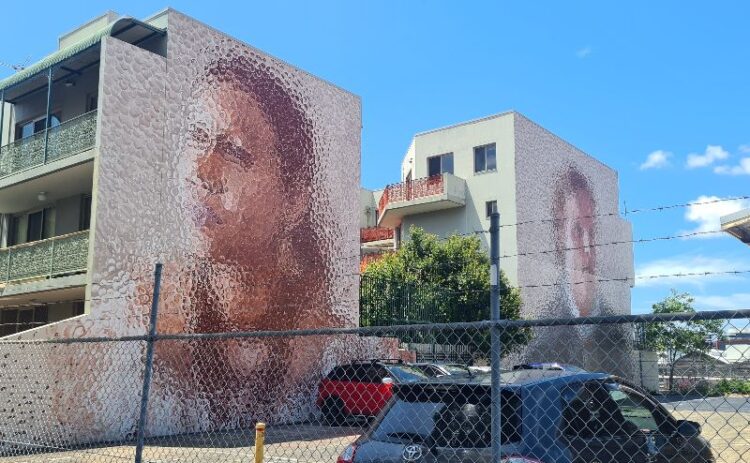
The conversations documented in Dawes’ diaries, particularly his interactions with Patyegarang, are vital to maintaining an understanding of the original Sydney Aboriginal language today.
“For me, it’s just a perfect story because so many figures in the early colonial period were associated with destruction of culture, compared to people that worked to preserve language and preserve culture. “I wanted to honour those figures, the people that actually work to preserve, not just destroy.”
Fintan Magee
Patyegarang contributed immensely to preserving the native language of Sydney and stands as a powerful leader in Aboriginal peoples’ efforts to conserve culture.
Where: 510 Wilson Street in Darlington.
Aboriginal Artworks in the Sydney City Centre
Portrait of Jenny Munro
Stretching up ten stories of the Novotel building in Haymarket is a titanic portrait of Wiradjuri elder and activist Jenny Munro.
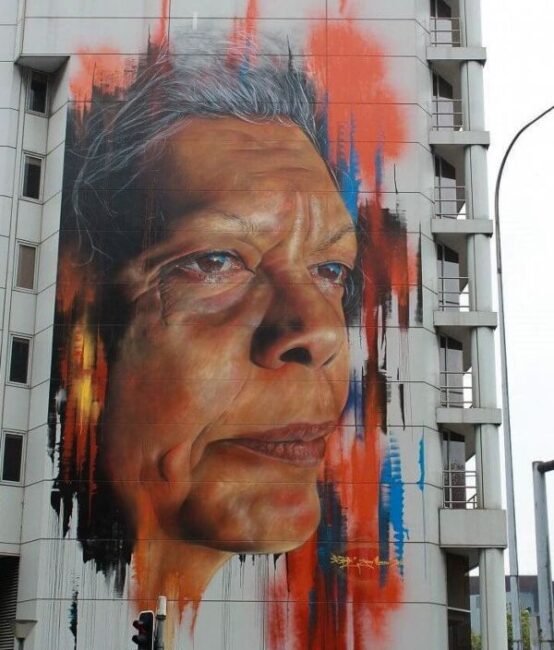
Painted over just five days by mural artist Matt Adnate in 2016, the portrait attempts to capture the larger-than-life personality of Munro in a much larger-than-life format. A co-founder of the Aboriginal Housing Corporation, Munro has been at the forefront of the struggle against the government and big business to socially cleanse the inner city of poor and especially Aboriginal people.
“If I’m making enough noise for mainstream Australia to take notice of me, maybe the Government should start listening to me before I come knocking on their door.”
Jenny Munro
Now, with her stern gaze overlooking the Chinese Gardens in the middle of Sydney’s Darling Harbour district, Munro hopes the portrait will raise awareness for her fight.
Where: on the corner of Goulburn and Harbour Streets
In Between Two Worlds
A splendid testament to the myriad dimensions of modern Indigenous selfhood, In Between Two Worlds was brought to life by the Aboriginal-Chinese artist Jason Wing. His combined heritage is a rich wellspring for his art, something clearly evident in this piece. Located near Dixon Street, this special location was often chosen for family gatherings by the artist himself.
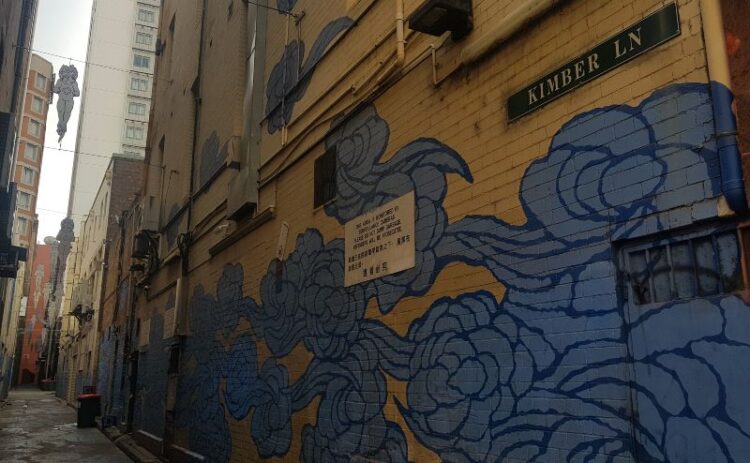
In this remarkable artwork, you’ll observe references to the elements of wind, water, fire, and earth, a striking combination of Aboriginal and Chinese motifs. Half-human, half-spirit figures in the piece stand as symbols of our ancestors, spanning from the past and the present into the future. A tribute to the universal motifs of heaven and earth, it delivers a heartfelt expression of admiration for those who came before us.
Where: Kimber Lane, Haymarket
I Stay (Ngaya ngalawa)
I Stay (also known as Ngaya ngalawa) was installed by American artist Jenny Holzer in 2014.
Situated on a column supporting the Mirvac Group building in 8 Chifley Square, this installation electronically animates the words of a wide variety of Aboriginal and Torres Strait Islander authors, poets, songwriters, and artists.
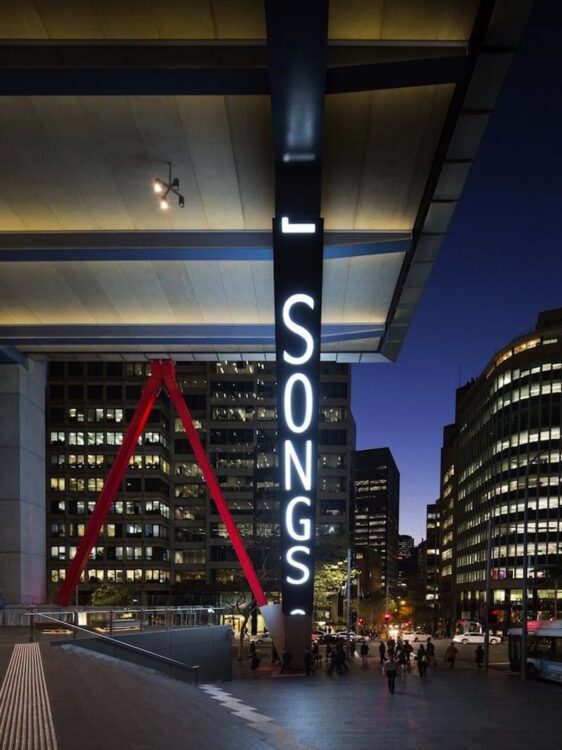
Holzer’s aim was to create a work that integrated and honoured the personal, using first-person voices informed by Aboriginal history but appealing to universal human themes.
Its alternate title, Ngaya ngalawa, means “I stay” or “sit”, in the language once spoken throughout the greater Sydney region, and I Stay sits as a reminder of Aboriginal Australia’s defiant survival in heart of modern Sydney’s CBD.
Where: Chifley Square & George Sydney Sydney
Yininmadyemi
Meaning “Thou Didst Fall” in English, Yininmadyemi has caught eyes in Hyde Park ever since it was installed by artist Tony Albert in 2014.
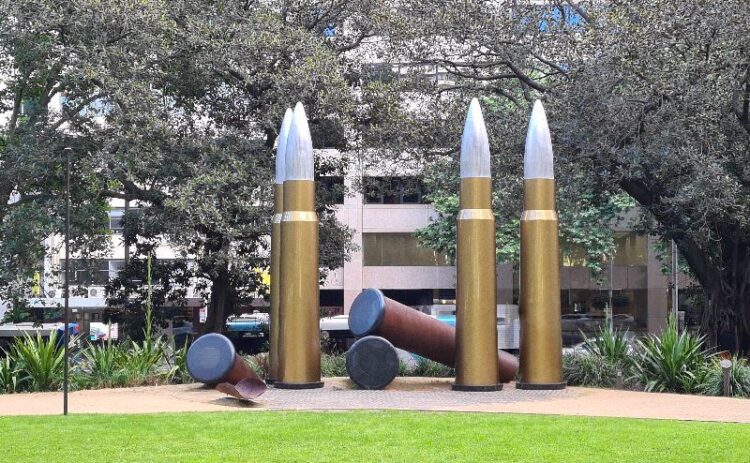
A very striking piece, Yininmadyemi is a series of seven-meter-tall bullets, arranged in a boomerang pattern: with four of them standing and three spent casings lying on the ground.
The bullets themselves are modeled on the .303 rounds that Australian soldiers used in combat throughout the 20th century and were inspired by a part of Albert’s own family history.
The artist’s grandfather, Eddie Albert, was an indigenous soldier during the Second World War. After being captured by the Italian Army in Libya, after a group, including Eddie Albert, attempted to escape from their POW camp three were executed, and these are represented by the piece’s three spent casings.
Yininmadyemi is a reminder of the harsh sacrifices Aboriginal people have made throughout Australia’s history, both fighting against its army and as part of it.
Where: Hyde Park near the War Memorial
Edge of the Trees
Completed in 1995, artists Janet Laurence and Fiona Foley’s sculpture Edge of the Trees can be found in the Museum of Sydney’s forecourt. Consisting of 29 pillars, all made from various materials, Edge of the Trees takes its name from a quote by historian and archaeologist Rhys Jones.
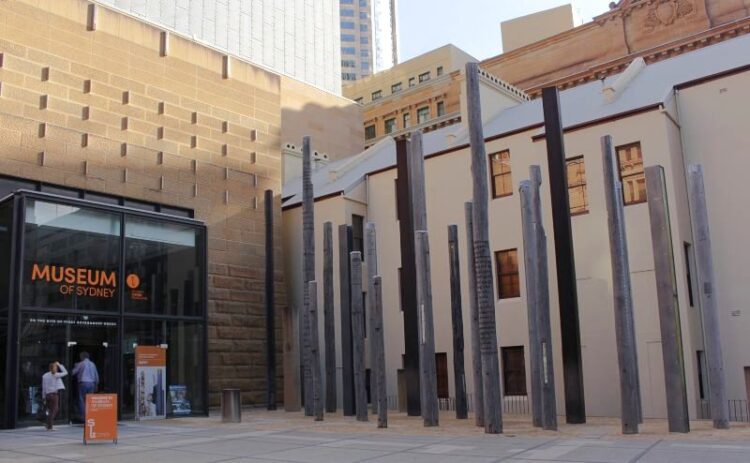
Describing the first contact between Europeans and Indigenous people, Jones described “…the ‘discoverers’ struggling through the surf […] met on the beaches by other people looking at them from the edge of the trees.” Laurence and Foley’s sculpture attempts to capture and represent that moment, a moment that took place very close to the museum’s modern location.
The ethereal pillars are accompanied by a soundscape of voices that recite the traditional names of the country that was taken from them. Here, Laurence and Foley have created not just a monument, but a feeling.
Where: Museum of Sydney
Aboriginal Artworks in The Botanic Gardens
Bara
Launched in May 2022, Judy Watson’s bara is the fourth Eora Journey artwork. Located on the Tarpeian Precinct Lawn above Dubbagullee (Bennelong Point), this major new permanent artwork celebrates Eora Fisherwoman and the traditional custodians of Gadigal Country and the clans of the Eora Nation.
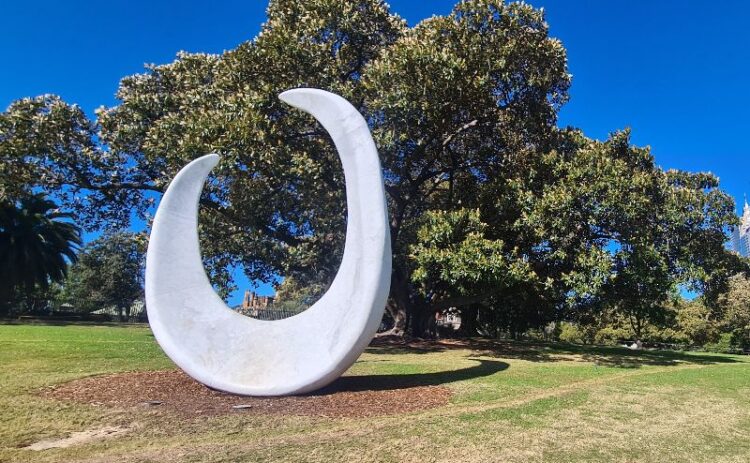
The impressive sculpture draws attention to the rich history of Gadigal women and their proficiency in fish catching, using specifically-crafted hooks.
The hooks, fashioned beautifully with a gleaming finish, mimic the look of local seashells, creating a vibrant element in the artwork. The women would set sail in their traditional nawis (canoes), use the bara attached to carrejun strings, and roast the caught fish over open fires.
Where: Tarpeian Precinct Lawn. Royal Botanic Gardens, Sydney
Wuganmagulya (Farm Cove)
In the heart of the Royal Botanic Gardens, you’ll discover an impressive terrazzo artwork by Gurindji, Malngin and Mudburra woman Brenda L. Croft.
Croft’s pathway features two sections showcasing depictions of rock carvings from Sydney, some extinct. Along the kerb, the pathway carries inscriptions in red, displaying names of individuals, places, animals, tools, and ceremonies, representing a diverse range of Indigenous clans and language groups from the Sydney region.
Not only does it cast a glance back to historical events, it also illuminates key moments in recent indigenous history, such as the momentous ‘1988 Long March for Peace, Justice, and Hope’.
Where: Foreshore, Royal Botanic Gardens
Veil of Trees
Situated within the Royal Botanical Gardens, Veil of Trees was installed by Janet Laurence and Jisuk Han in 1999.

The installation is a series of 21 glass panels, placed alongside and amongst over a hundred red forest gums, integrating the natural and the artificial in an eye-catching manner that aims to center the indigenous botanical history of the site.
The panels encase natural elements like native honey and grass seeds and feature poems from famous Australian writers, such as Les Murray and Judith Wright, through which the brilliant light of the Australian sun reflects and refracts.
The installation is effectively a work in progress, as the trees and bushes around the panels continue to grow, and regenerate what was until recently a barren knoll.
Where: Mrs Macquaries Road north of the Art Gallery
YuraBirong
The YuraBirong sculpture, beautifully crafted in 2011, was once a Forest Red Gum tree in the Garden for over two centuries.
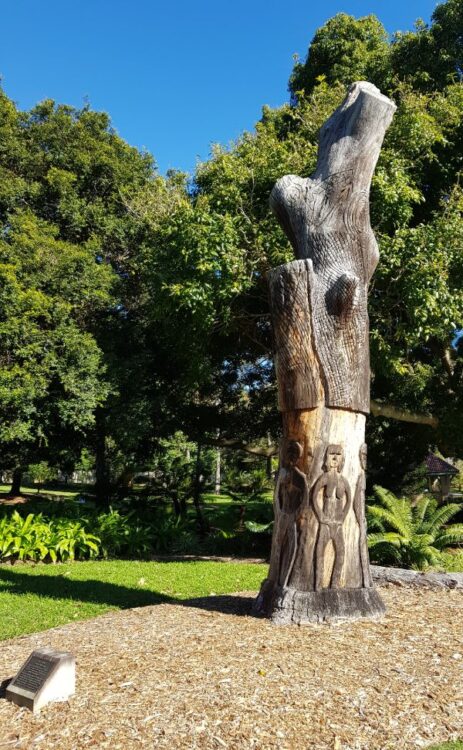
This artistic masterpiece was brought to life by Aboriginal artists Glen Timbery and Vic Simms. Serving as a touching tribute to Australia’s Aboriginal ancestors, YuraBirong—translating to ‘People of this Place’—beautifully signifies the rich indigenous culture.
Where: Royal Botanic Gardens
Remembering Arabanoo – Quay Quarter Lanes Artworks
The Quay Quarter lanes are steeped in historical significance as they formed the grounds of initial contact between the traditional owners and the new settlers. A key figure in this story is Arabanoo, whose involvement is frequently noted in the early chronicles of the colony. It is thought that Arabanoo’s resting place lies in close proximity to the lanes.
Wiradjuri and Kamilaroi artist, Jonathan Jones, created five artworks celebrating Arabanoo.
Betūŋigo (oysters) -The artistic representation of cast-bronze oysters adorning the sandstone surface of the Gallipoli Memorial Club represents the oyster shell middens created by Aboriginal peoples over countless generations.
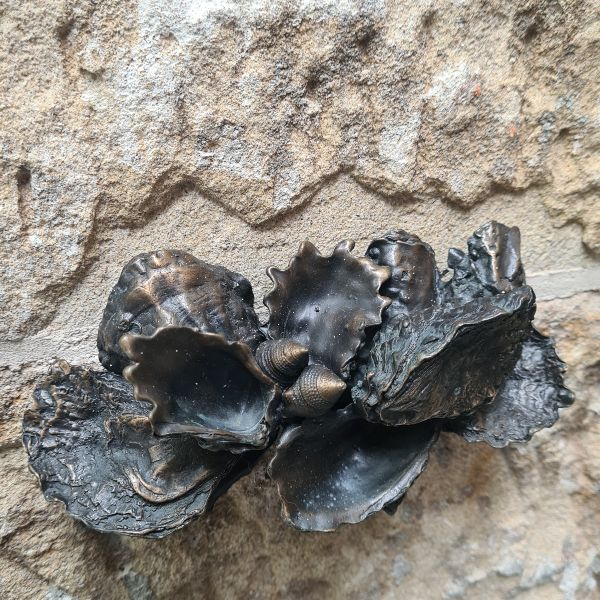
Sydney’s middens were largely destroyed to produce lime mortar, a crucial component of colonial architecture.
Weerong (Sydney Cove or harbour) – This artwork features the sea with a ceiling that lights up in waves as you walk beneath
Magora (fish scales) – A beautiful art piece made from repurposed marble graces the paving stones on Loftus Lane. Collected from the demolished lobby of a building in Bridge Street, the work pays homage to the significant role Magora (fish) played as a vital food source for the local Eora people.
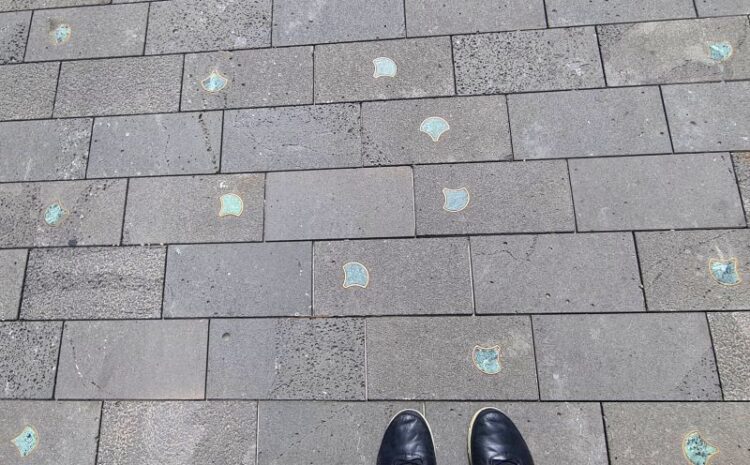
Over 1,000 such pavers are imaginatively scattered across the lane. A reminder of the fact that Quay Quarter stands firm on First Nations’ land.
Bengdee (ornament) – a distinctive 13-metre-long concrete wall that bears a repeated design of a shackle and a feather.
Gwara (wind) – uses flags to illustrate the transfer of language and is visible from Loftus Street.
Where: Loftus Lane, off Loftus Street Sydney
Indigenous Artworks in Barangaroo and Darling Harbour
shellwall 2015
On the outside of Alexander Residences in Barangaroo’s southwestern corner, you might notice a cascade of flawless white shells. This impressive piece is the shellwall, the result of a collaboration between Bidjigal/Eora elder Esme Timbery and Wiradjuri/Kamilaroi artist Jonathan Jones.
This striking piece of art comprises oversized aluminium shells and carefully detailed cut-out shapes. It stands as a grand tribute to the shell-making traditions in the Sydney Aboriginal community at La Perouse, showcasing its deep-rooted cultural knowledge.
Where: 25 Barangaroo Ave, Barangaroo
Murals and Sculptures in Inner Sydney
Gadigal Mural
This captivating public artwork is the collaborative effort of three Aboriginal artists – Dennis Golding, Lucy Simpson, and Jason Wing. They artistically represent both the natural terrain and cultural heritage of Gadigal country.
East to west, between Crown and Palmer streets, this expansive mural spans over 25 metres in length and soars to 17 metres in height. Its design is full of curved lines and circular shapes symbolising Sydney’s geographical features and the routes tread by the Gadigal people prior to European arrival. It’s filled with bold black outlines and vivid shades of ochre red and yellow, which represent the rich historical and cultural practices of the Gadigal people. The mural is a sensitive homage to this site’s historical significance.
Where: Barnett Lane, Darlinghurst
Yirranma Place Gates
Before his significant contributions to Yirranma Place, previously a Church of Christ, Scientist and now a hub for the Ramsay Foundation, Bates hadn’t explored the craft of blacksmithing.
William Brian “Badger” Bates, an elder of the Barkandji people, has earned acclaim for his distinct lino prints. His artistic prowess can be admired in the Art Gallery of NSW, along with various other collections spread across Australia.
This work encapsulates three towering gates, each standing an impressive three metres tall. These gates are more than mere structures – they depict enthralling indigenous tales of the Seven Sisters and the Rainbow Serpent. If this isn’t captivating enough, Bates has enriched the cultural narrative with a striking mural embellishing the interior ceiling.
Where: 262 Liverpool Street, Darlinghurst
I Have a Dream
One of Sydney’s best-known pieces of street art, the I Have A Dream mural, was painted in August 1991 by Juilee Pryor and Andrew Aiken, a now-convicted murderer who painted the piece after fleeing Britain.
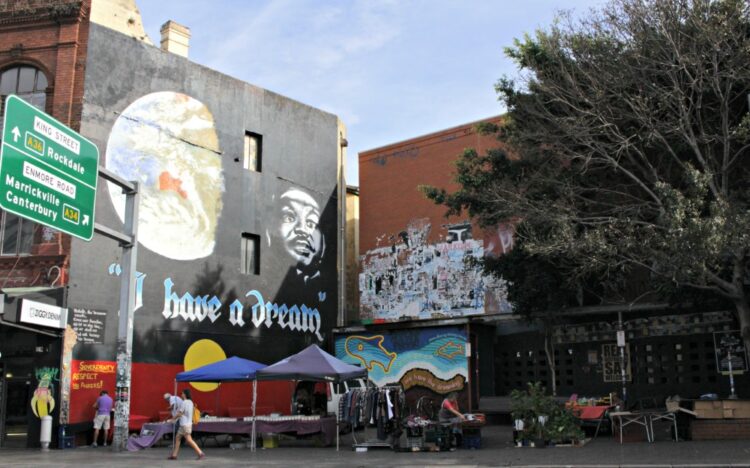
Its dark origin story, aside from I Have A Dream, has become a part of the landscape of Newtown’s King Street in Sydney’s inner west and was recently heritage listed by the local council.
With the Aboriginal flag girding the bottom, a portrait of African American Civil rights leader Martin Luther King is at the centre of the piece, his half-silhouetted face alongside a depiction of the Earth we all share.
Where: King Street Newtown
Find more inner west murals here
Aboriginal Street Art and Sculpture in Sydney Map
Resources for learning more about Aboriginal Art in Sydney
- Art Gallery of NSW – Yiribana Gallery
- Learn more about Sydney’s Indigenous Culture on The Barani website
- Wentworth Galleries
Have questions about things to see and do in Sydney?
Head over and join our Facebook Group and we will be happy to help.
